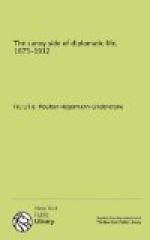All her mirrors were covered with black stuff of some kind; she did not wish to see the sad relics of her beauty.
At eleven o’clock every evening she took a walk with her maid around the Place Vendome. She stayed in bed all day, never rising till twilight, and receiving no one but one or two old admirers who were faithful to the end.
Her things (haillons they were called in official language) were sold at auction—piles of old ball-shoes, head-gear, gloves stiffened with moisture and age. Apparently, she never gave anything away, but hoarded her treasures, which after her death were swept in corners and smelled of mold and damp.
We are named to Berlin. I am very sorry to leave Paris; I was getting quite accustomed to its little ways. Johan went to the Elysees to present his lettres de rappel. It seems only yesterday he went to present his lettres de creance. The President gave him the Grand Cordon of the Legion d’honneur, and to me the beautiful service de Sevres called “La Chasse,” a surtout de table of five pieces. This is only given to royalty or Ambassadors. One cannot buy it, as it belongs to the French government. I heard that they hesitated between giving me that or a piece of Gobelin tapestry. I was glad they chose the surtout de table. It will be useful in two ways—as a subject of conversation and as a beautiful souvenir of our stay in Paris.
BERLIN, 1902-1912
BERLIN, January 22, 1903.
Dear L.,—J.’s presentation of his lettres de creance to the Emperor was a small affair compared with former functions, which were combined with gala coaches, powdered coachmen, and pourboires. It was simply taking a train to Potsdam, in which there was a section called Kaiserlich. The Minister of Foreign Affairs accompanied him, as was his duty. In a royal carriage from the court they were driven to the Neues Palais. J. was met by the Introducteur des Ambassadeurs (Herr von Knesebeck) and conducted into the presence of the Emperor, where J. made his speech. The Emperor was very official and ceremonious when he responded, but in the conversation afterward was affability itself. J.’s audience with the Empress was very hurried, because of the Crown Prince of Denmark, who had arrived the night before in Berlin. He stayed two days at Neues Palais.
I arrived two weeks after this. The custom here is for a Minister’s wife to be presented by the doyenne (Madame Sjoegeny) to the grande maitresse (Countess Brockdorf) on one of her reception-days before the Schleppenkur. I found her very charming. My audience with the Empress was fixed for a date a week later, and the Swedish and the Peruvian Ministers’ wives were to be received at the same time.




